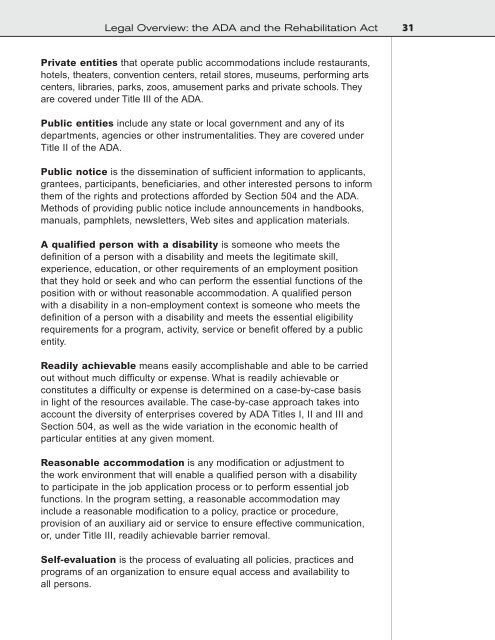Design for Accessibility: A Cultural Administrator's Handbook
Design for Accessibility: A Cultural Administrator's Handbook
Design for Accessibility: A Cultural Administrator's Handbook
You also want an ePaper? Increase the reach of your titles
YUMPU automatically turns print PDFs into web optimized ePapers that Google loves.
Legal Overview: the ADA and the Rehabilitation Act 31<br />
Private entities that operate public accommodations include restaurants,<br />
hotels, theaters, convention centers, retail stores, museums, per<strong>for</strong>ming arts<br />
centers, libraries, parks, zoos, amusement parks and private schools. They<br />
are covered under Title III of the ADA.<br />
Public entities include any state or local government and any of its<br />
departments, agencies or other instrumentalities. They are covered under<br />
Title II of the ADA.<br />
Public notice is the dissemination of sufficient in<strong>for</strong>mation to applicants,<br />
grantees, participants, beneficiaries, and other interested persons to in<strong>for</strong>m<br />
them of the rights and protections af<strong>for</strong>ded by Section 504 and the ADA.<br />
Methods of providing public notice include announcements in handbooks,<br />
manuals, pamphlets, newsletters, Web sites and application materials.<br />
A qualified person with a disability is someone who meets the<br />
definition of a person with a disability and meets the legitimate skill,<br />
experience, education, or other requirements of an employment position<br />
that they hold or seek and who can per<strong>for</strong>m the essential functions of the<br />
position with or without reasonable accommodation. A qualified person<br />
with a disability in a non-employment context is someone who meets the<br />
definition of a person with a disability and meets the essential eligibility<br />
requirements <strong>for</strong> a program, activity, service or benefit offered by a public<br />
entity.<br />
Readily achievable means easily accomplishable and able to be carried<br />
out without much difficulty or expense. What is readily achievable or<br />
constitutes a difficulty or expense is determined on a case-by-case basis<br />
in light of the resources available. The case-by-case approach takes into<br />
account the diversity of enterprises covered by ADA Titles I, II and III and<br />
Section 504, as well as the wide variation in the economic health of<br />
particular entities at any given moment.<br />
Reasonable accommodation is any modification or adjustment to<br />
the work environment that will enable a qualified person with a disability<br />
to participate in the job application process or to per<strong>for</strong>m essential job<br />
functions. In the program setting, a reasonable accommodation may<br />
include a reasonable modification to a policy, practice or procedure,<br />
provision of an auxiliary aid or service to ensure effective communication,<br />
or, under Title III, readily achievable barrier removal.<br />
Self-evaluation is the process of evaluating all policies, practices and<br />
programs of an organization to ensure equal access and availability to<br />
all persons.


